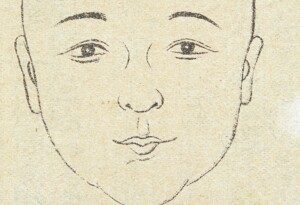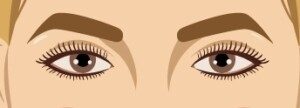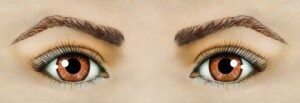Mark’s autistic daughter is six and finds eye contact very uncomfortable.
But she’s made much progress with techniques designed to improve eye contact.
Is eye contact a social construct or are we genetically hardwired to put a high premium on it?
Some say it’s a social construct because in some countries, eye-to-eye contact is considered a sign of rudeness and disrespect.
However, in those countries, people are taught that from an early age.
They are conditioned to unlearn what comes naturally for them. The social construct, then, is avoidance of eye contact.
Some autistic people find eye contact uncomfortable, even intolerable, while other Autists have minimal to no issues with it.
I was diagnosed as autistic in middle age, and my assessor told me that a person could have good eye contact and still be on the autism spectrum.
I’ve never had struggles with eye contact. But not all autistic individuals are the same.
“My daughter was diagnosed with autism when she was two years old,” says Mark Joseph, a digital marketer living in St. Louis, MO.
“One of the first signs that something was wrong was that she wouldn’t make eye contact with anyone,” continues Mark.
“When we realized our daughter was avoiding eye contact, we felt it was maybe because we were doing something wrong that had created this barrier.
“We couldn’t pinpoint what it was, but we knew we had to do something about it.”
After she was diagnosed with Autism Spectrum Disorder, her parents sought out therapies to help her become more comfortable with them and the world around her.
“After seeking professional help, we discovered our daughter had difficulties with eye contact because it was too overwhelming for her,” explains Mark.
“Too much information would flood in when she made eye contact with someone, which would cause her great distress.
“However, we wanted to help her to make eye contact with people — as it would help her in social situations.”
Why Eye Contact Is Important in Interactions
Eye contact isn’t always done to make a neurotypical (person without autism or other neurodiversity) feel comfortable — as some believe.
Eye contact is crucial in a world where appearing skittish and insecure could backfire.
It’s especially important for women to yield good eye contact, as this projects confidence and feeling in control. Imagine if a woman at a board meeting avoided eye contact.
If you’re working on helping your autistic child improve eye contact, you are doing the right thing and should not feel guilty about this.
It will help them tremendously as they get older and must interface with people in a variety of situations.
Improving Eye Contact in an Autistic Child
Mark explains, “We have been working with her therapist to improve her eye contact. He told us about the desensitization therapy process.
“This is a process where you help your child become more comfortable with what is causing them anxiety or distress.
“So, in our daughter’s case, we would work on gradually increasing her eye contact.
“For this, we did some easy exercises at home where we would watch a movie or show on TV and pause it for a while.
“Then, we asked her to maintain eye contact with the person on the screen for however long she felt comfortable.
“At first, she only lasted a few seconds before looking away. However, with practice, she improved greatly.
“Each time she managed to make eye contact, we rewarded her with one of her favorite toys as an encouragement strategy which helped her become more comfortable with making eye contact.”
Working on improving eye contact in an autistic child should not be seen as an attempt to appease NTs.
Instead, parents should see this as a way to make their child come across as more self-assured and not easily intimidated. Autistic children are three to four times more likely to be bullied when compared to NT children.
- A person is more convincing with good eye contact.
- A person will not be taken nearly as seriously if they avert gaze when involved in an important conversation.
- Avoiding direct gaze may be perceived as giving control to the other individual in the conversation.
- “Good eye contact” need not be a continuous, unrelenting stare.
Other Techniques for Improving an Autistic Child’s Eye Contact
“Another technique that we found helpful was to use a social story,” says Mark.
“For example, we would tell her a story where a character has to make eye contact with someone to communicate effectively.
“We would help her understand that making eye contact is an important social norm and that it is okay to feel overwhelmed by it sometimes — but that she can get through it.
“We would also remind her of the times when she made eye contact with someone and how good it made her feel.
“This helped her understand the importance of eye contact in social situations.”
Another technique: “The trick is to start slowly and gradually move closer to the eye.
“We usually ask her to start holding the gaze somewhere near the eyes, like on the forehead or eyebrow. Then she moves closer to the eye and holds it there for a few seconds.
She also found a new way to help her with this. She would put a dot on her forehead and look in the mirror.
“Then she would look at the dot while talking to herself in the mirror. This has been helping her a lot in making eye contact and keeping it for longer periods.”
Another approach might be to have your child maintain eye contact on a photo of someone’s eyes.
If this is difficult, you can begin with rudimentary depictions of eyes, and gradually progress to more concise depictions as your child becomes desensitized or acclimated to the image at hand.
Below is a series of eye depictions, with increasing prominence, that can help acclimate an autistic child to holding eye contact with actual people.

Eyes 1

Eyes 2. Empetrisor, CC BY-SA 4.0/creativecommons/licenses/by-sa/4.0/Wikimedia Commons

Eyes 3. CC BY 4.0/creativecommons.org/licenses/by/4.0/ Wikimedia Commons

Eyes 4

Eyes 5. Bostjan46, CC0, via Wikimedia Commons

Eyes 6. libertad0, CC BY-SA 3.0/creativecommons/licenses/by-sa/3.0/Wikimedia Commons

Eyes 7. Qbqq, CC BY-SA 4.0/creativecommons.org/licenses/by-sa/4.0/Wikimedia Commons

Eyes 8. Click2pharmacy.co.uk Images, CC BY 2.0/creativecommons/licenses/by/2.0/Wikimedia Commons

Eyes 9. Viktoria Borodinova, CC BY-SA 4.0/creativecommons/licenses/by-sa/4.0/Wikimedia Commons

Eyes 10
What makes eye contact so troublesome for an autistic child?
“I remember wondering the same thing about my daughter after we started eye contact exercises with her therapist,” says Mark.
“It was the first time she ever gave me a comprehensive response on this topic.
“She said, and I recall, ‘It’s just too much. It is difficult to process all the information when I make eye contact. It’s like being in a dark room and suddenly turning on a bright light. Everything is just too much to take in all at once.’
“Her reaction caught me off-guard; I had never considered it from that perspective.”
Mark’s daughter is very intelligent and articulate; those were her words.
“It made sense why she would rather not make eye contact with others, as it’s sensory overload for her to take everything in at once.
“When she makes eye contact with someone, she feels like she is being bombarded with too much information.
“She has a habit of counting everything in a room when she enters, like the number of doors, windows, floor tiles, or other decorative objects.
“She also tries to identify the color of each object. To top it all off, it overwhelms her when she sees people’s faces and their expressions while talking to them.
“She can only focus on one or two things at a time. Trying to focus on multiple things is just too much for her.
“This is why she usually avoided eye contact because it was just too overwhelming.
“Thankfully, she is slowly getting used to it and learning how to cope with this ‘overload’ of information.
“With time and practice, she will be able to make eye contact more often and for longer periods.”
What NEVER to Do if Your Autistic Child Avoids Eye Contact
I’ve read in autism forums and on Facebook postings by autistic adults who said that they were struck in the face or actually beaten by a parent when they didn’t give that parent eye contact.
Oddly, some have said that this made them learn eye contact.
Well, if beatings can make a child learn eye contact, so can humane, non-harsh techniques.
Furthermore, the opposite occurred in a few of these autistic individuals: They claim to overdo eye contact because the fear of their abusive parent still resides inside them.
If your child can’t look you in the eye, do NOT take this personally; he or she is certainly also avoiding eye contact with others as well.
Mark’s daughter, for instance, was avoiding eye contact with even her classmates. With therapy, this has improved.
NEVER scold, reprimand or punish your autistic child for lack of eye contact.
Mark Joseph lives in St. Louis, MO with his wife and two children.
 Lorra Garrick has been covering medical and fitness topics for many years, having written thousands of articles for print magazines and websites, including as a ghostwriter. She’s also a former ACE-certified personal trainer. In 2022 she received a diagnosis of Level 1 Autism Spectrum Disorder.
Lorra Garrick has been covering medical and fitness topics for many years, having written thousands of articles for print magazines and websites, including as a ghostwriter. She’s also a former ACE-certified personal trainer. In 2022 she received a diagnosis of Level 1 Autism Spectrum Disorder.










































